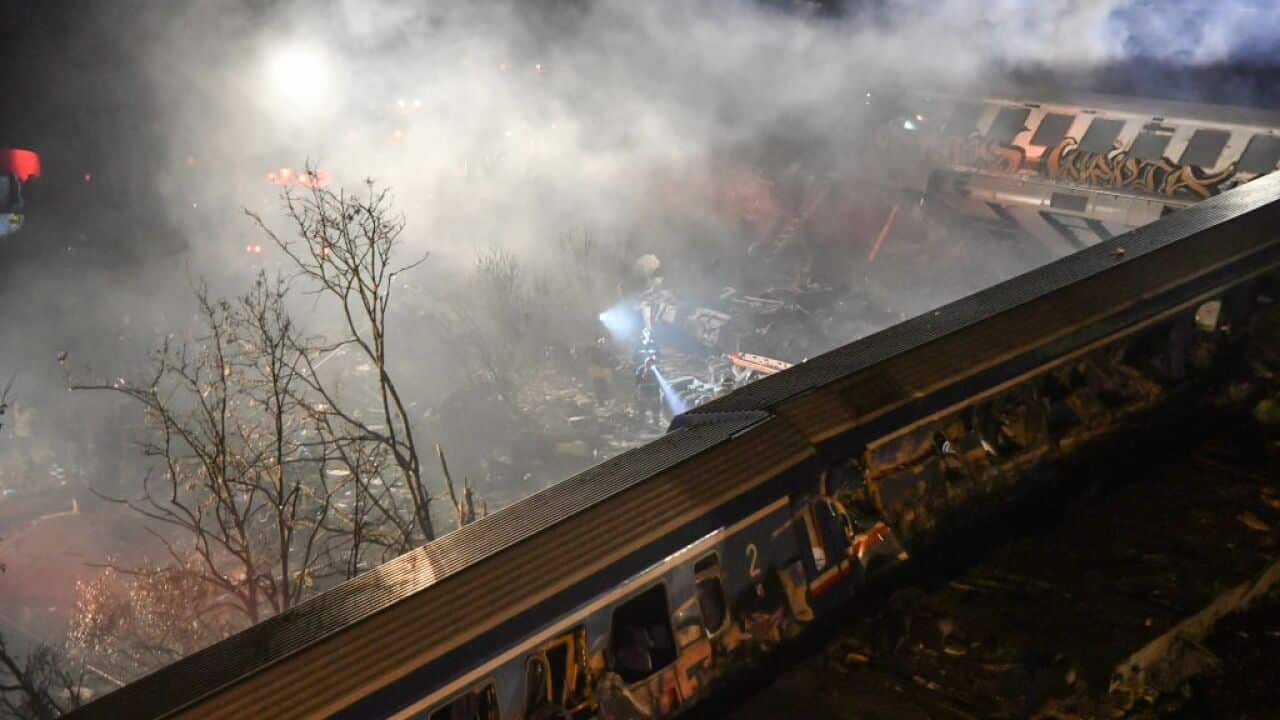Key Points
- At least 36 people have been killed and dozens more injured in a train collision in central Greece.
- An intercity passenger train collided at high speed with a cargo train outside the city of Larissa.
- The government declared three days of national mourning, with flags flying at half-mast in a tribute to the victims.
A passenger train and a cargo train have collided head-on in Greece, killing at least 36 people and injuring dozens as the country's deadliest rail crash in living memory threw entire carriages off the tracks.
The death toll was expected to rise further, a fire brigade official said. Sixty-six of those injured were hospitalised, six of whom in intensive care, the official said.
The crash occurred as the passenger train emerged from a tunnel. Derailed carriages, badly damaged with broken windows and thick plumes of smoke, could be seen on the site.
"We heard a big bang, [it was] 10 nightmarish seconds," said Stergios Minenis, a 28-year-old passenger who jumped to safety from the wreckage.
"There was panic ... the fire was immediate, as we were turning over we were being burned, fire was right and left."
A passenger who escaped from the fifth carriage told Skai TV: "Windows were being smashed and people were screaming ... One of the windows caved in from the impact of iron from the other train."
The passenger train was carrying 342 travellers and 10 crew, while two crew were on the cargo train, according to Hellenic Train data.
Many were evacuated to Thessaloniki, where one woman ran to embrace her daughter as she disembarked from a bus with other survivors. Another woman, who was waiting there, said her child was not picking up the phone.
The head of emergency unit in Larissa hospital Apostolos Komnos said most of the victims were young people, in their 20s.
Many of the passengers would have been returning home after a long holiday weekend marking the beginning of Greek Orthodox lent. Thessaloniki has a large student population.
Government declares days of national mourning
The government declared three days of national mourning, with flags flying at half-mast in a tribute to the victims of the crash.
"We still don't know the exact number of victims, we will investigate the reasons for (the crash) in full transparency," Infrastructure and Transport minister Kostas Karamanlis, in tears, told reporters.
One of the questions investigators need to answer is why the two trains were, according to Thessaly regional governor Konstantinos Agorastos, running on the same track when they crashed.

A picture taken with a drone shows firefighters and rescue crews working to extricate passengers from trains after a collision near Larissa city, Greece. Source: AAP / Achilleas Chiras/EPA
Greece's ageing railway system is in need of modernising, with many trains travelling on single tracks and signalling and automatic control systems still to be installed in many areas.
'We are living through a tragedy'
In the morning, cranes were lifting derailed carriages, as rescuers scoured through the wreckage.
Fire brigade spokesperson Vassilis Varthakogiannis said the evacuation of passengers took place in very "difficult conditions given the severity of the collision of the two trains".
"We are living through a tragedy. We are pulling out people alive, injured...there are dead," he said.
The cargo train had been travelling from Thessaloniki to Larissa. Local media said the train left Athens around 7.30 pm local time on Tuesday. The fire brigade said it was informed of the accident shortly before midnight.
Greece sold railway operator TRAINOSE to Italy's Ferrovie dello Stato Italiane in 2017 as part of its international bailout program, expecting hundreds of millions to be invested in rail infrastructure in the coming years.
According to the Italian company's website, it is the main provider of rail transport for passengers and freight in Greece and runs 342 passenger and commercial routes a day.


